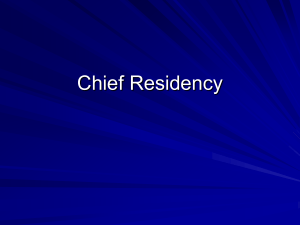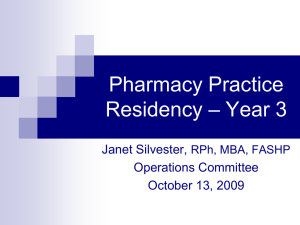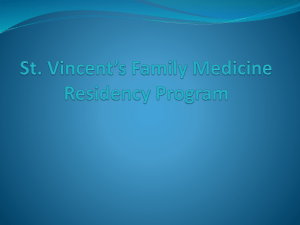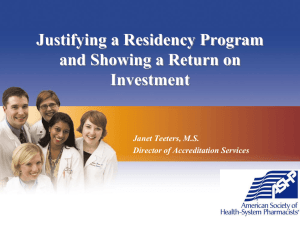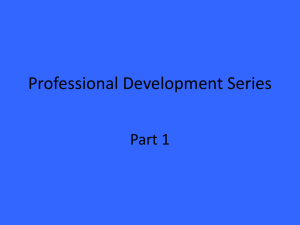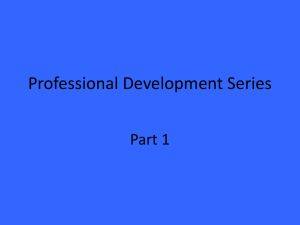Status of Academic Emergency Medicine in the U.S.A.
advertisement
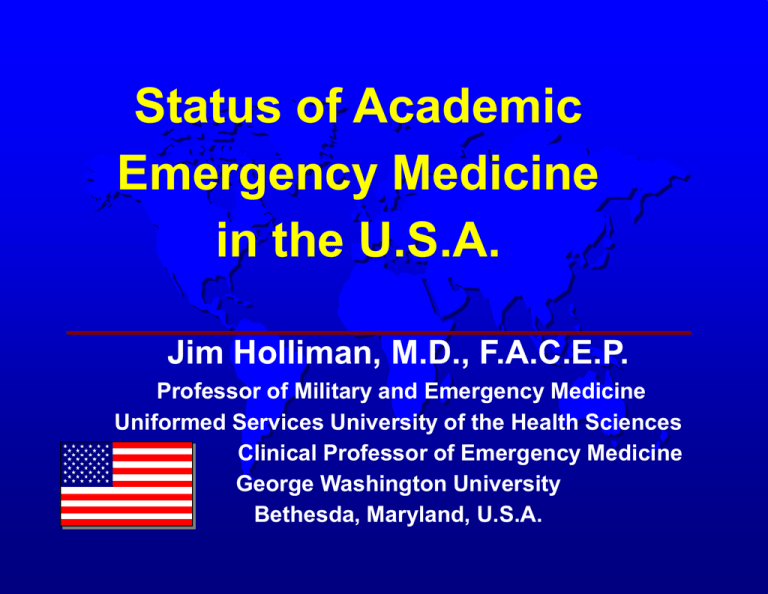
Status of Academic Emergency Medicine in the U.S.A. Jim Holliman, M.D., F.A.C.E.P. Professor of Military and Emergency Medicine Uniformed Services University of the Health Sciences Clinical Professor of Emergency Medicine George Washington University Bethesda, Maryland, U.S.A. Current Status of Academic Emergency Medicine in the U.S.A. : Lecture Outline Provide updates on the current status of U.S. : –Emergency Medicine (E.M.) in general –E.M. residency programs –E.M. training for medical students –Society for Academic Emergency Medicine (SAEM) –E.M. Research –Opportunities for international E.M. collaboration General Importance of E.M. in the U.S.A. E.M. is the first specialty to develop directly due to demand by the public –Other specialties are defined by anatomic region, particular type of disease, or particular age group of patients E.M. encompasses all types of medical & surgical problems and all age groups E.M. provides "safety net" in the national health care system for patient access to unscheduled care Aspects of E.M. Which Benefit Other Medical Specialties in the U.S.A. Allows other specialists to concentrate on their areas of expertise & interest Decreases need for other specialists to be physically present in the hospital Permits patients to be promptly evaluated when presenting at times inconvenient for other specialists Allows effective screening of patients for hospital admission Beneficial Efficiency Effects of E.M. on the U.S. National Health Care System Prompt evaluation of emergencies Completion of diagnostic workups in single visits Reducing admission rates to inpatient services Limiting need for interhospital transfers Allowing coordination of care by other specialists for patients with multiple medical problems Benefits of E.M. to the General Public Reassurance and confidence Convenience Ensured access to care Education –Illness & injury prevention –Correct utilization of health care system –Appropriate followup care Benefits of Having Specialty Residency Training in E.M. Provides core of specialists to staff emergency departments (E.D.'s) Provides physician leadership –E.D. administrators or managers –Prehospital care system directors –Coordinate outpatient & inpatient care Ensures quality, depth, and uniformity of training for emergency care Benefits of Training Other Specialty Residents in E.M. Allows ability & confidence in managing basic emergencies Familiarizes them with E.D. operations and needs Improves working relationship with E.M. faculty & E.M. residents Allows them to learn cost-effective use of ancillary tests Benefits of Training All Medical Students in E.M. Ensures exposure to proper emergency management of common conditions Meets public expectation that all doctors should know basic emergency care Encourages some of students to pursue E.M. residency training Allows students to appreciate the knowledge, areas of expertise, & skills of the E.M. physicians Some may develop interest in pursuing E.M. research projects Unique Subjects to Teach Students and Residents in the E.D. Cost-effective ancillary test ordering Efficiency in patient flow Managing multiple simultaneous patients Coordinating prehospital and E.D. care Focused approach to medical problems Minimum Basic Subjects to Teach Medical Students & Residents in the E.D. Recognition of emergencies Airway management CPR Focused evaluation of : –Headache –Chest pain –Dyspnea –Abdominal pain –Fever Suturing / wound care General Structure of U.S. Recommended E.M. Training for 1st & 2nd Year Medical Students E.M. faculty involvement with lectures on basic & applied physiology Extracurricular lectures on clinical topics Extracurricular "workshops" or "labs" : –Suture technique –Airway management –Blood drawing –Intravenous line placement –Splint & cast application –EKG interpretation –X-ray interpretation General Structure of U.S Recommended E.M. Training for 3rd & 4th Year Medical Students 3rd year : –Observational elective in E.D. ( 2 to 4 weeks) –Elective in prehospital (ambulance) care 4th year : –1 month elective ( or required) in E.D. –1 month elective in Toxicology –1 month elective in prehospital care –Students interested in career in E.M. (applying to E.M. residency) should do 2 months of E.D. electives General Recommended E.M. Training for Residents from Other Specialties Internal Medicine, Family Practice : –1 month in 1st year, 1 month in 2nd or 3rd year General or Orthopedic Surgery, Anesthesia, Otolaryngology : –1 month in first year Obstetrics & Gynecology , Pediatrics : –1 month in 2nd or 3rd year Radiology, Pathology, Psychiatry, Ophthalmology : –May NOT need an E.M. rotation General Structure of U.S. E.M. Residency Programs 75 % of programs are PGY 1,2,3 15 % of programs are PGY 2,3,4 –Require "rotating" or "transitional" internship first 10 % of programs are PGY 1,2,3,4 A few programs are 5 year combined residencies (E.M. / pediatrics, E.M. / Medicine) Must be accredited by national Residency Review Committee –Strict standards are same for all programs General Structure of U.S. E.M. Residency Programs (cont.) > 50 % of time (> 18 months) in program must be in the E.D. Important "off-service" rotations : –Critical care units (pediatric, medical, surgical) –Trauma surgery –Pediatrics –Orthopedics –Anesthesia –Medicine / cardiology Non-E.D. E.M. Rotations Usually Included in E.M. Residency Programs Toxicology Pre-hospital care Aeromedical care (flying usually optional for residents) Research 1 to 2 months of electives Career Options for E.M. Residents Graduating from U.S. Programs Private practice –Single hospital physician group –Multi-hospital physician group Academic practice –Mix of clinical work, teaching, research –Usually work harder & get paid less Administration –E.D. director –Prehospital system director Additional fellowship training Locum tenens work U.S. E.M. Fellowship Training Programs (following E.M. residency) Emergency Medical Services (Prehospital care) : 1 to 2 years Toxicology : 2 years (separate subspecialty certification) Pediatric E.M. : 2 years E.M. Research : 1 to 2 years E.M. Administration : 1 year E.M. Education : 1 year Hyperbaric Medicine : 1 year Sports Medicine : 1 to 2 years Critical Care (Intensive Care) Medicine : 1 to 2 years Aeromedical Care : 1 year International E.M. : 1 to 2 years (may include obtaining an M.P.H. degree) Facility Requirements for U.S. E.M. Residency Programs Patient census > 30,000 (total) per year Pediatric census 15 % or 4 months full time equivalent Critically ill / injured patients : at least 4 % of census or > 1000 per year At least 2000 patient encounters per resident per year Accredited medicine & surgery residencies must be at same clinical site Must have offices for faculty & residents Stat lab results should be available in < 1 hour Must have at least 5 hours per week didactic instruction by faculty Requirements for Residents in U.S. E.M. Training Programs May not work > 12 hours continuously in E.D. May not work > 72 hours per week Must have at least one day off in every 7 days Must be relieved of clinical duties sufficient to attend at least 70 % of scheduled conferences > 50 % of rotations & clinical time must be in E.D. Must keep a procedure logbook Must have followup information on admitted patients May not be supervised by resident physicians from specialties other than E.M. when in the E.D. Faculty Requirements for U.S. E.M. Residency Programs Department chief must have : –E.M. board certification, administrative & clinical E.M. experience, academic achievement, involvement in medical organizations, same authority as other institut\ional chiefs Program Director must have : –E.M. board certification, > 3 years experience, be clinically active, be scholarly active Teaching Faculty must have : –One per every 3 residents, 25 % of time protected for academic activities, some must do research, most must be E.M. board certified, must provide 24 hour a day E.D. coverage Current Status of the Specialty of E.M. in the U.S.A. Core component of U.S. health care system – > 100 million visits per year Mature, respected specialty Independent specialty board exam : the American Board of Emergency Medicine (ABEM) –Subspecialty certification (pediatric E.M., toxicology, sports medicine) Independent Residency Review Committee Popular as career choice among medical students Popular with the public (thanks to TV) Extensive current research efforts 2005 Statistics on E.M. in the U.S.A. 135 residency programs 3978 residents enrolled > 22,000 ABEM certified E.M. physicians > 35,000 total E.M. physicians in practice > 22,000 American College of Emergency Physicians (ACEP) members > 5000 SAEM members 4750 E.D.'s Background of E.M. Considered as a "Primary Care" Specialty Current situation in the U.S. is that the government thinks more "primary care" physicians are needed Goal is > 50 % of physicians in "primary care" "Primary Care" defined as : –Pediatrics, Internal Medicine, Family Practice, Obstetrics & Gynecology U.S. government is increasing political & financial support for primary care but decreasing it for specialty care Status of E.M. in the U.S.A. as a "Primary Care" Specialty E.M.'s struggle to achieve recognition as a distinct specialty has led to reluctance to be declared a "primary care" specialty However, E.M. does provide a large portion of primary care in the U.S. So most look on E.M. as a "special case" specialty deserving government support E.M.'s only "deficiency" related to providing primary care is its lack of providing "longitudinal care" Legislative Efforts by E.M. on Behalf of the Public "Prudent layperson" laws to ensure access to care Support for prehospital care systems Injury prevention Violence control Measures to limit driving while intoxicated Public education Social - Societal Problems in the U.S. Which E.M. is Trying to Correct Interpersonal violence –Assaults –Gunshots –Homicide –Suicide –Spouse abuse –Child abuse –Elder abuse Social - Societal Problems in the U.S. Which Result in Increased Need for E.M. Tobacco smoking Alcohol abuse –Driving while intoxicated –Most common cause of serious vehicle accidents –Violence / assaults Obesity Lack of health insurance Child and elder neglect Current U.S. Government Pressures on the U.S. Medical Training System Stimulus comes from the government wanting to spend less $ on health care : –Reduce number of residency positions –Reduce number of medical school graduates –Decrease number of foreign graduates in U.S. training programs –Require foreign graduates to return to their home country after training –Restrict government funding to support only 3 years of residency training per resident The Society for Academic Emergency Medicine (SAEM) Main U.S. organization devoted to promoting academic E.M. (specifically teaching and research) Holds annual meeting (5 day duration) & 5 annual regional research presentation meetings Publishes Academic Emergency Medicine journal Monthly newsletter Has 29 different committees, task forces, & interest groups (International is largest one) > 500 research abstracts at annual meeting Status of E.M. at U.S. Academic Medical Centers About half of the 125 U.S. medical schools have E.M. as a fully independent academic department In the other half, E.M. is usually a division of the Dept. of Medicine or Surgery (but is often defacto independent) E.M. faculty often have greater clinical workload than other academic faculty E.M. rotations for medical students are usually elective rather than required Some of the Research Areas in Which E.M. Researchers Play a Leading Role Fluid resuscitation CPR ACLS Asthma Injury prevention Pain management Disaster management E.M. Peer - Reviewed Journals U.S.A. : –Annals of E.M. (A.C.E.P.) –Academic E.M. (S.A.E.M.) –American Journal of E.M. –Journal of E.M. (C.A.E.P.) –Prehospital & Disaster Medicine (W.A.D.E.M.) –Prehospital Emergency Care –Pediatric Emergency Care –Emergency Medicine Clinics –Topics in E.M. –Journal of Wilderness & Environmental Medicine E.M. Non-Peer Reviewed Journals Emergency Medicine News Journal of Emergency Medical Services Emergency Medical Services Air Medical Journal Journal of Air Medical Transport Emergency Medicine Current Status of Academic E.M. in the U.S.A. : Summary E.M. occupies key role in U.S. health care system E.M. provides potentially useful training for all medical students and for residents from other specialties E.M. residency training is the standard for supplying physicians to staff E.D.'s Despite current difficulties, the future for U.S. academic E.M. appears bright
